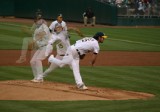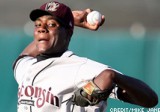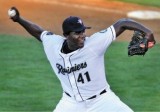Maddux and Haren have beautiful deliveries from an injury-prevention stand point.
Granted I've never seen Pineda pitch, but I trust Shields' eye-view on this one.
Pineda is definetly intriguing if he can stay healthy. A Raffy Soriano type career path wouldn't be a disaster either.
 We'd been struggling to come up with an MLB archetype who matches to the attributes that the Bane of High Desert is reported to have. But hey, in the fewest-walks leaderboard, we ran across Danny Haren:
We'd been struggling to come up with an MLB archetype who matches to the attributes that the Bane of High Desert is reported to have. But hey, in the fewest-walks leaderboard, we ran across Danny Haren:
- 6' 5"
- 91-94 fastball
- 7+ K, yet 1+ walks
- Upright, arm-intensive delivery
Until somebody comes up with a better comp, I think I'll go with Haren ...
.............
In the comments, it was suggested that Pineda might have a high-elbow, generally-violent, top-heavy delivery.
Any problemos with Pineda's delivery would obviously relate to his health, rather than his command, since he evidently already has more command than most ML starters.
Just talking archetypes, of course:
.......
1. Most RH pitchers who can hit postage stamps with a baseball have upright, arm-only* deliveries. Think Greg Maddux, Brad Radke, Catfish Hunter, Paul Byrd ... indeed, Dan Haren.
It's pretty tough to hit gnats when you're using a max-effort, drop-and-drive Kevin Appier approach.
In principle, I wouldn't ask Pineda to engage his lower body more, if he's "hitting targets on flies at 1,000 yards."
Not that posters are suggesting that's what the M's do, but in 2006 couldn't you just see the M's roving coaches get excited about Pineda and overhaul his delivery to drop-and-drive? :- )
 By the way, Austin Bibens-Dirkx had a 50:9 control last year, thanks for axing.
By the way, Austin Bibens-Dirkx had a 50:9 control last year, thanks for axing.
......
2. If Pineda has an inverted W at the top, and if an inverted W is a risk for shoulder injury, then I guess the good news would be that Pineda's (reported) type of delivery puts the pressure on the elbow rather than the shoulder.
Maddux, Catfish, super-control RH guys like that, do you associate them with shoulder injuries?
Of course, if Pineda (or Felix, for that matter) were scheduled for Tommy John tomorrow, it would surprise exactly nobody.
.....
3. As a general principle, the Oakland A's have (evidently) had good results with pitcher health because they deploy pitchers, rather than throwers.
Great K/BB ratio, in and of itself, is a pretty cool predictor for future health. All pitchers are risk indicators, but I'm even more worried about a guy who hasn't learned how to pitch, than one who has.
....
 4. I would be surprised to see Pineda achieving 8:1 control ratios with a violent, jerk-the-shoulder-around-the-corner, accelerate-too-suddenly, max-effort kind of motion.
4. I would be surprised to see Pineda achieving 8:1 control ratios with a violent, jerk-the-shoulder-around-the-corner, accelerate-too-suddenly, max-effort kind of motion.
But like the man says, it will be nice to find some vids. I'm sure the posters weren't hallucinating, and the pics (not vids) I've seen on the net do look a bit funky.
Pineda's elbows sit high, he gets his power from above the waist ... more to the point, it's just not especially graceful-looking, in Maddux fashion. Check the awkward angle of his mitt in the photo above. Just quibbling...
Wouldn't surprise if, at 20, Pineda had to muscle the front shoulder, considering the high CG you see here.
Am not analyzing, just chatting. But if Pineda is muscling his acceleration a little, my first question would be whether he could benefit from leaning back and reaching to CF, as Haren and Felix do. Whatever you do, don't lower his CG when he's hitting spots like he is...
.....
It's interesting to hear that Michael Pineda throws mostly with his arm, in the Maddux-Catfish-Haren mold. The M's response to his elbow soreness in 2009, as usual, was to shut him down at the first sign of pain, even if it be 50 innings after the start of the year.
Not many 20-year-old pitchers make it to 25. Hopefully Pineda's K/BB will see him through :- )
Cheers,
Dr D
Comments
what an injury-prevention delivery is. :- )
.................
the only time I ever saw anybody try to predict which pitchers would get injured and which wouldn't, it was Baseball Prospectus' PAP system predicting injuries for pitchers with high scores... and James shut that system down by showing that the high-PAP pitchers stayed healthier than other pitchers.
It is SO hard to isolate variables on pitcher mechanics. I've never seen any studies that effectively isolated, say, high front side (like Pineda's) and measured the injury rate against control groups. Have you?
The inverted W reference in the last thread WAS NOT meant for Pineda.
Just clearing that up.
Just got an email saying I should get that video on Sunday. Should make this debate a little more interesting...
Given my druthers, I'd rather Pineda hadn't had any soreness in his elbow, but the 48:6 control at High Desert, and the superlatives from the scouts as to his command, move him right to the top of the charts.
Hard to imagine Zack Greinke performing better at High Desert than Pineda did.
I know Maddux is one of Chris O'Leary's favorite examples for great mechanics, but as mentioned, there is no conrete way to analyse mechanics from a health standpoint. It comes down to every person being different, being able to withstand different amounts of pressures.
Let's keep in mind that he only threw 40 innings there. Still impressive, but it's only a few innings more than Robles threw in his HD stint, and you didn't seem very eager to jump to conclusions based on that sample.
Here are some great shots of Pineda, if you want to see him at different points in his motion. (Four Seam Images, by the way, is a great place to look up virtually any minor leaguer if you want to get a look at them. Unfortunately, all their photos are protected and they charge a lot for them. These are the guys that provide photos to MiLB.com/MLB.com, BA, etc.) If you want to use the thumbnails in your posts, just copy the image location and add ".jpg" to the end of it.
Here's a slightly more recent writeup by JAC on Pineda (11/2008). Probably about the same as the Seattle P-I link you provided in an earlier post, but may as well throw it out there. Also, JAC's Midseason top 30 has some good info. That may be where my idea that he's a future reliever was spawned.
1) The scouts' raves about Pineda being able to hit a fly at 1,000 yards, variously repeated, and 2) the fact that a 8:1 control ratio is many standard deviations better than a 1.8 to 1 control ratio.
As well, it's the general template that Pineda shows -- the tall, rangy RH who has mastered his mechanics so early, despite using 3 pitches -- that is different from all the other talented pitchers.
Hey, I like Robles. And Juan Ramirez. They're not platypuses like Pineda is.
Pineda certainly had the track record to back his 2009 performance up.
At Four Seam Images. BOOKMARK with gusto.
And... beginning with the stroke forward, a much better motion than I was hoping for.
Drop the front elbow, and beginning with the kick forward that is a Randy Johnson stroke -- chest forward, beautifully over a perpendicular front shin, easy sidearm sling. The sideways release of the front arm is just gorgeous.
I share your view that the front elbow is way too high. That's not really a high front side; it's just an awkward front arm.
(others) notice again that JAC had Pineda as the prospect of the year before High Desert.
A lot of the times we're wondering, "why doesn't Joe Shlabotnik get more attention?" when the insiders of the game were two years early on us. And being as Jason talks to so many pro scouts, it's a good reason why his voice should be weighted heavily by MC/SSI'ers.
Tuiasosopo is another example.
A scout mentioned in the 11/08 JAC article that Pineda gets on top of the ball. How, you ask, considering he throws sidearm?
Check pictures #8 and #11 at the Four Seam Images link that Jon provided. Some other pitcher, at release, could have his wrist bent down a bit further towards the ground, even slightly under the ball.
After release, notice that the fingers have come over the ball at release.
Getting on top of the ball isn't a question of forearm angle. It's a question of making sure you don't cut under the ball and "sail" it, and Pineda's a great example of how a sidearmer does it right.
Well, pic #11 is most likely a changeup, which is why his wrist is pronated so severily. His palm is facing 3B. He needs to stay on top of the slider, and it's very rare to find a guy that pronates a slider, so I'm not sure that's a good illustration for that point. But #8, definitely.
As various pictures around the 'net show. In which case his index and middle fingers wouldn't be touching as they are in the photo.
Freddy Garcia used to turn his hand over the FB like that. Lot of guys do these days. Just about anybody who's getting hard tail into a RH batter is going to have his palm facing 3B on the followthrough.
But that's not what I was going for. I have a hard time believing he's pronating like that on a slider (the point I was trying to make). Pineda's problem has been getting underneath the slider, throwing slurvey type breakers rather than a hard breaking slider. I would like to see his release on a slider.
Anyways.. my brain is going funny. Time to catch some zzzz
And no surprise if he's slurving some of those. Hard to imagine the kid having it down pat in class A ball.
... get some sleep man. :daps:
No obvious timing problem there as far as I can see (vid is needed to know for sure). It looks like has some hyperabduction at foot plant though.
The video should show us more.
Something said in passing above made me wonder ... IS there a link between pitching injuries and walk rate? I mean, really. If you could go get a list of all of the TJS or rotator cuff guys for the past 15 years, what would you find in regards to their minor league walk rates, (especially compared to guys who pitched for years in the majors w/o lots of DL time)?
I suspect that you'd find high walk rates as "suggestive", (but perhaps not predictive), of future arm problems -- and low walk rates as potentially predictive for good health.
As noted above, every body is built different. When talk of mechanics begins, the first step is almost always to try and find guys with similar body types, because mechanics for a guy 6'8" 180 are GOING to be massively different than a guy 5" 8" 180. But, I would suspect that typically, pitchers avoid injury by mostly doing what their body does NATURALLY ... and here's the important point --- REPEATING that motion.
If I had to guess, (and I do have to guess), I'd imagine that the root of most injuries is NOT the most repeated mechanical sequence for a pitcher --- it is more likely what happens when he FAILS to repeat that motion that injury occurs. A guy with poor control could have many different causes ... release point, arm slot, leg drive ... or just plain fear. But, these kids have repeated their basic motion thousands, (10s of thousands?) of times before getting drafted.
I think some mechanical flaws are associated with injuries, not because they are alone "dangerous" -- but more likely, that it's easier to "flub" your way from those motions into one that IS harmful. But, walk rates "might" be a tell for how often does a pitcher increase his personal risk of injury. How often does he change his armslot that extra half inch that turns that whippy arm motion from strange looking to actually harmful?
It would be an interesting study.
http://www.proballnw.com/wp-content/uploads/2009/10/MichaelPineda_0512.mov
Not as bad as I remember. Still don't like the way his arm snaps around, though. Slow motion clips a little later.
http://www.proballnw.com/wp-content/uploads/2009/10/pinedaslow.gif
Not nearly as extreme as Strop, but does look a little like Sonnanstine. Is in good shape at footplant from a timing perspective, but that elbow is ~20 degrees higher than I'd like it.
I think I let my imagination run wild since the last time I saw the vid. He looks mechanically sound across the board outside of the hyperabduction.
That said, this video is from May, and he still looks pretty deliberate. I've been told that his injury occured soon after they tried to speed him up. It would be interesting to see video of him immediately before the soreness came about as well as after he recovered.
Whatever amigos think of his math, or whatever, we've all got to give it up for him in terms of his feel for the panorama of baseball history...
James for 30-40 years has watched Royals (and other) teenage pitchers come up and get hurt, and his resolved opinion is that they get hurt mostly because they are throwers, not pitchers... Give him a kid who can hit spots, who is pitching when very young, and he likes the chances to stay healthy much better when they're polished, at a young age...
Worth consideration IMHO...
................
At the same time, Pineda did have to be shut down after 50 IP, so a Mark Lowe conversion the next thing we hear, will surprise exactly nobody...
Will take a look also when get a chance... interesting and substantive input on your part as always Jon...
If I've done that once, I've done it 1,000 times BTW... pick out some attribute of a player, and a year later, emphasized it in my mind way more than it looks the next time round... I think that is part of the way the human mind organizes information...
Good stuff.
I see the hyperabduction, but not everyone that does this is in severe danger. What I don't see is an out of balance mechanic. He's firmly over his CG line, lands with absolute control in the same spot on the mount every time, ends up in GOOD FIELDING POSITION, etc...all marks of a pitcher who's going to have outstanding command. If he has enough arm strength and shoulder strength to take the hyperabduction...he's a star in the making.
...he's still a grade-A prospect. If he goes to the pen, he's our closer of the future and he probably gets here by 2010 September. If he starts...he's here by 2012.
"If he has enough arm strength and shoulder strength to take the hyperabduction...he's a star in the making."
But he's already dealing with elbow problems! They were described to me as "soreness/stiffness" and possibly tendinitis. That's the type of thing that has a good chance to keep cropping up.
Stiffness is not something you want to hear in conjunction with the elbow. Often the loss of flexion is a result of the elbow slamming shut on supinated releases, which cause the ulna to grow. It's a condition that cannot be corrected with surgery and may lead to bone spurs down the road. The way his arm whips around... agh.
If he had a clean bill of health then maybe I'd shrug it off like you, but since he missed most of the year I'm a little worried.
Anyways.. Because of his great control Pineda is going to have a big league career if he can stay healthy, but I still think Ramirez and maybe Cortes and Robles have higher upside (although I'm still skepitcal of Robles given his size).
It's the probability of hitting his potential that makes Pineda riskier in the minds of some. Ramirez and Robles might have equivalent potential (not Cortes...Cortes is a moron)...but not greater potential. What they MIGHT have is greater chances at hitter their potential.
The slow-mo confirms that Pineda doesn't have any timing problems whatsoever.
He does have some pretty clear hyperabduction and mediocre hip/shoulder separation (which will put more stress on the upper body/arm and limit his velocity potential). While his followthrough is solid in the slow-mo, its inconsistent and mediocre at times in the first video - In particular #1,#4,#5 deliveries he doesn't let his pitching arm deccelerate and it snaps back in a herky-jerky motion.
I'd categorize him somewhere between above-average and high risk considering the mechanics/age/injuries, though hes not a train wreck by any means. Most likely hes a reliever, but he should stay in the rotation until proven otherwise.
For the last couple of seasons Ramirez has been viewed as a potential #2/#3 while Pineda is a potential #3/#4. Not a ton of seperation, and neither is viewed as a potential ace, but I've never seen a report that categorizes Pineda as a high upside guy.